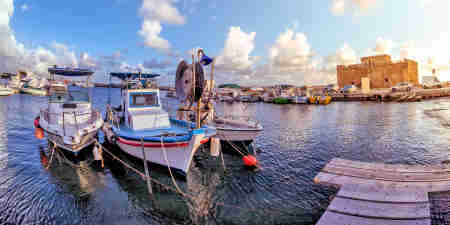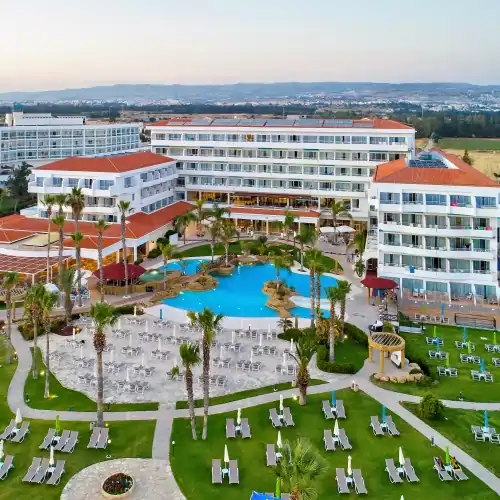- Book Now
- Home Page
- Destinations
- City Guides
- City Guides
 Explore Paphos
Explore Paphos Explore Protaras
Explore Protaras
- Special Offers
- Weddings
- Meetings & Events
- About Us
- Contact Us
- Get A Quote
- Manage your Bookings
- English
A short drive from Protaras, Ayia Napa Medieval Monastery is a religious, architectural, and historical landmark, attracting hundreds of tourists as it counts among the most important monuments of its kind in Cyprus.
It is unclear when it was founded, however, it has a fascinating legend that tells of a hunter discovering an icon of the Most Holy Virgin Mary in a cave while chasing his prey in the forest. The hunter’s dog was distracted by a radiant light coming from the cave that revealed the image of the Mother of God. Later, the cave became the first church of the monastery.
At the heart of the courtyard of the monastery, there’s a gazebo with a beautiful legend. A Venetian girl from a wealthy family ran from home when her parents refused to marry her to a commoner she loved. The two-story building at the northern side of the courtyard was the home of the girl. The church here is Venetian too, dating from the 1500s when the nunnery was shaped around it. At the entrance of the monastery, by the gate, there’s a large sycamore tree said to be planted by the heroine of the story, who, unable to marry her beloved, became a nun and joined this very monastery. She is buried under the gazebo.
In its current form, the Ayia Napa Medieval Monastery dates from the Venetian era - 1489-1571, however, the gate was erected in the Middle Byzantine period (1191). The arched gallery is from the Ottoman era.
Ayia Napa Medieval Monastery no longer operates as a nunnery but hosts now a museum with a large collection of archaeological finds from the area, as well as icons and other religious artefacts, most of them from the private collection of Archbishop Makarios.
Read More
Read Less






Not much is known about the Agioi Saranta Cave Church in Protaras, but it is well worth visiting. It stands in a spectacular setting, hidden in a rock formation, on the way from Ayia Napa to Protaras in the Fanós area.
It’s a day trip hiking endeavour to reach the quirky religious attraction and the rugged route may be challenging if you are not prepared. Wear proper shoes and come prepared to fight the heat, with water, sunscreen, and a hat to protect you against the scorching sun. There are no signs to guide your walk to the church – but you cannot get lost. Walk towards the hills and it will eventually appear in front of you like magic at the end of a wooden stairway.
It is unknown when the church was built. There’s a blue door at the entrance, but it’s always unlocked, allowing the visitor to enter at any time. Its interior is bare – kept probably just as it was for hundreds of years. Some icons adorn niches carved into the rock. There are also a couple of chairs where the faithful can rest, pray, or meditate. There’s a small window, an opening above the door, and a hole in the dome that allow plenty of natural light inside.
The name Agioi Saranta translates into English as the Holy Forty – probably referring to the Forty Martyrs of Sabaste – a group of Roman soldiers of the Legio XII Fulminata killed by Roman emperor Licinius I in 320 AD when they refused to renounce their Christian fate. The feast day of the Forty Martyrs of Sebaste is March 9, when many Christian devotes come to pay their respects at the Agioi Saranta Cave Church.
Read More
Read Less




Profitis Ilias is a treasured Greek Orthodox church on a rocky outcrop some fifteen minutes from the centre of Protaras. Its magnetic setting and stunning architectural features lure tourists to climb over 150 stone steps to reach its doors. It’s a tiresome walk, but well worth it, as the rewards are not only of religious nature. The views of Protaras from Profitis Ilias can only be described in superlative terms. The panoramic views stretch from Cape Greco all the way to Kapparis, and even to Famagusta on a clear day.
On the way to the church of Profitis Ilias, there are trees full of colourful ribbons. Each ribbon represents the memory of someone’s loved one, a wish, or a prayer, depending on the beliefs of the person who tied them onto the branch of the tree. There’s also a metal structure outside the church covered in ribbons with the same signification.
The church that stands at more than 100 meters above Protaras today was erected in 1984 using stone from the region. It is a Byzantine-style construction and a replica of a former temple that stood here as early as the 14th century.
It is dedicated to St. Elijah, or Elias, a prophet who lived in the 9th century BC. On the feast of St. Elijah on July 20th every year, the church attracts hundreds of devout Greek Orthodox pilgrims and a religious service is held to honour the saint.
Inside, the church is decorated with colourful murals depicting Orthodox saints. The altar is adorned by iconic representations of St. Elijah, Madonna with the infant Jesus, Christ Pantocrator, and other biblical scenes.
The church never closes its doors and it is floodlit at night. It’s an impressive sight from the distance, but also up close – many travellers prefer to see it after dark to take in the starry-eyed views of Protaras with hundreds of shimmering lights flickering in the distance.
The romantic setting of the church makes this site particularly suitable for weddings and wedding photography too.
Read More
Read Less


















